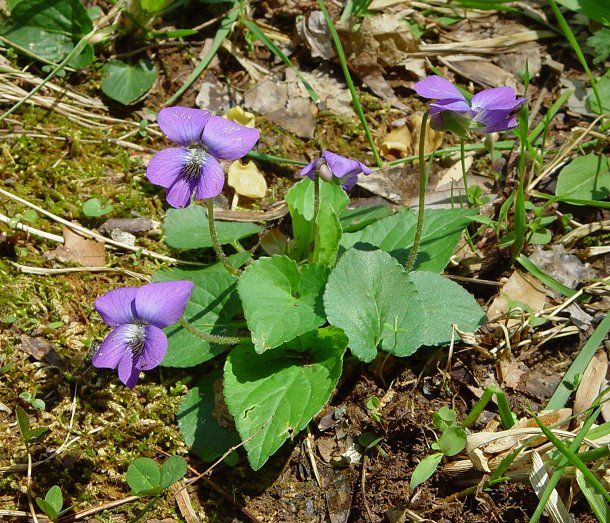Viola sororia Willd.
Common Violet

Native
CC = 2
CW = 0
MOC = 98
© DETenaglia
Viola sororia Willd.Common Violet | |
 |
Native CC = 2 CW = 0 MOC = 98 |
© DETenaglia |
|
Family - Violaceae Habit - Perennial forb, to 30 cm tall, with a prostrate to ascending rhizome 4-7 mm thick. Stems - A thick underground caudex. Aerial stems absent. Leaves - All basal, long-petiolate, the petioles to 15 cm long, glabrous or sparsely to moderately pubescent with fine, spreading hairs. Stipules conspicuous, membranous to somewhat herbaceous, free from the petiole, narrowly lanceolate, the margins entire, glandular-hairy. Leaf blades 1.5-9.0 cm long, slightly longer than wide to noticeably wider than long, ovate to broadly ovate, heart-shaped, or kidney-shaped, all unlobed, rounded or broadly angled to a bluntly or less commonly sharply pointed tip, cordate at the base, the margins finely to relatively coarsely toothed or scalloped their entire length or with the teeth somewhat larger and more widely spaced in the apical portions, the surfaces glabrous or more commonly finely hairy, when pubescent then both surfaces usually hairy.
Inflorescence - Single flowers on long peduncles from base of plant, mostly not or only slightly overtopping the leaves (those of the cleistogamous flowers prostrate or abruptly arched). Peduncles to 10 cm long, hirsute, curved at apex, with pair of opposite or sub-opposite bracts in upper half.
Flowers - Sepals 4-7 mm long, oblong-lanceolate to broadly lanceolate, rounded or more commonly angled to a bluntly or broadly pointed tip, the margins glabrous or minutely hairy, the basal auricles small and inconspicuous (0.5-1.0 mm long at flowering). Corollas 10-18 mm long, the petals oriented more or less forward in life but curved or arched outward or backward toward their tips, longer than the sepals, bluish purple to purple (with a greenish white throat) with darker veins, rarely all white or white with purple spots or mottling, the lateral petals bearded on the upper surface with uniformly slender hairs, the lower petal glabrous or with a few slender hairs on the upper surface toward the base, the spur conspicuous, usually well-exserted beyond the sepal auricles, stout and often somewhat hemispheric in shape. Stamens not exserted, typically not visible without dissection of the flower. Style slender, slightly expanded into a narrow, more or less scoop-shaped, hollow, truncate tip. Cleistogamous flowers also produced.
Fruits - Capsules 10-12 mm long, broadly ellipsoid to broadly ovoid or nearly globose, green to dark green or olive green, usually mottled with purple, drying to tan or olive brown, the surface glabrous. Seeds 1.8-2.5 mm long, brown to dark brown, sometimes mottled with purple. Flowering - March - June, occasional in most other months. Habitat - Forests, streambanks, pond margins, bases, ledges, and tops of bluffs, prairies, glades, savannas, fields, orchards, pastures, lawns, gardens, cemeteries, railroads, roadsides, and disturbed areas. Origin - Native to the U.S. Lookalikes - Several other species of Viola. Morphological variation can make identification to species tricky. Other info. - This is the most common violet in Missouri, occurring statewide. It is more or less ubiquitous across the eastern half of the continental U.S., and also ranges into Canada and Mexico. The plant is often easy to identify, at least to genus, by its general appearance. However, the variability of leaf shape can make differentiation from other species difficult in some cases. The leaf blades are generally as wide or wider than long, scalloped but without distinctive lobing, and cordate at the base. The flower color is also variable, as shown in the images above, but is most often deep purple. Many of these morphological variants have been named, and the taxonomy of the species complex has long been controversial. Photographs taken in Brown Summit, NC., 4-12-03 (DETenaglia); also at Weldon Spring Conservation Area, St. Charles County, MO, 4-2-2010, Engelmann Woods Natural Area, Franklin County, MO, 4-18-2014, and near Labadie, Franklin County, MO, 4-10-2019 (SRTurner). |